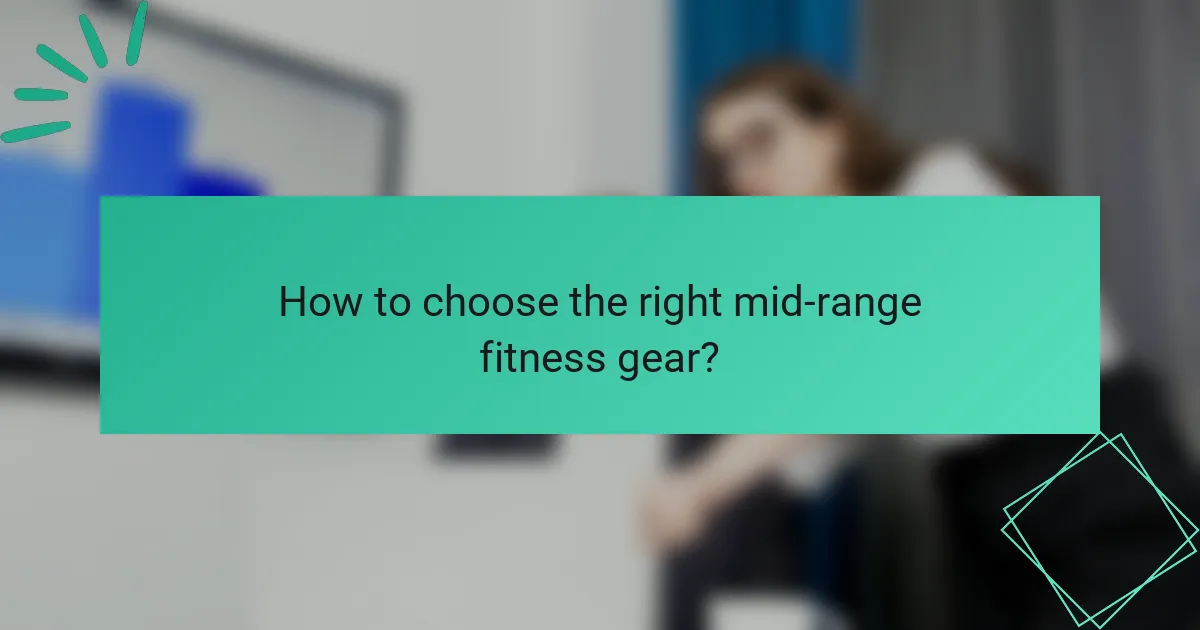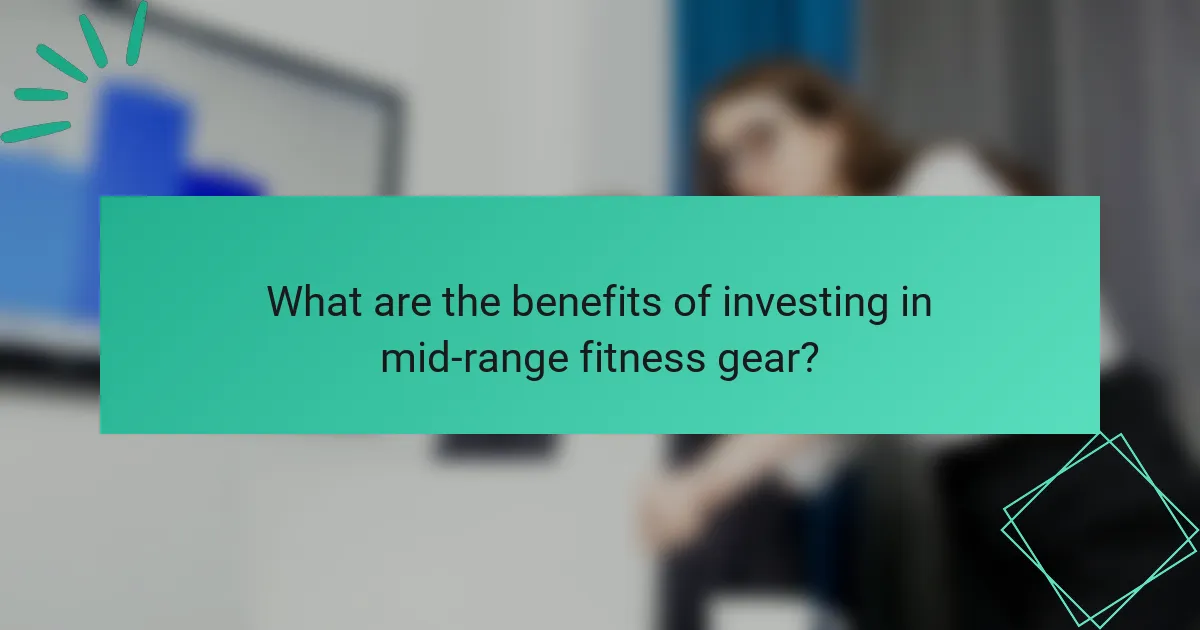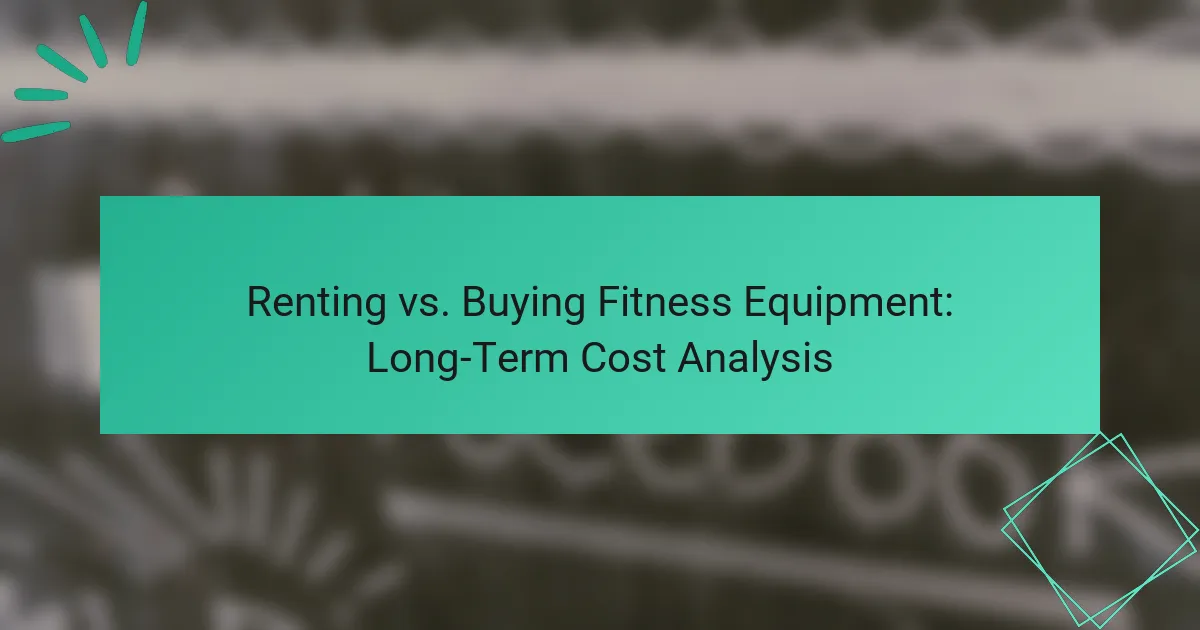Mid-range fitness gear in Australia strikes a balance between quality and affordability, typically priced between AUD 100 and AUD 250. This range offers durable, high-performance options that cater to regular workout enthusiasts without overspending. When choosing gear, it’s essential to focus on features that enhance comfort and functionality, ensuring you get the best value for your investment.

What are the best mid-range fitness gear options in Australia?
In Australia, mid-range fitness gear offers a balance of quality and affordability, typically ranging from AUD 100 to AUD 250. The best options combine durability, performance, and comfort, making them suitable for regular workouts without breaking the bank.
Nike Flex Experience Run 10
The Nike Flex Experience Run 10 is designed for versatility, making it ideal for both running and gym workouts. It features a lightweight mesh upper for breathability and a flexible sole that adapts to various surfaces.
When considering this shoe, look for a snug fit that supports your foot without being too tight. The cushioning provides adequate support for short to medium-distance runs, making it a solid choice for casual runners.
Adidas Ultraboost 21
The Adidas Ultraboost 21 is known for its exceptional comfort and energy return, thanks to its Boost midsole technology. This shoe is suitable for long-distance running and everyday wear, providing a plush feel underfoot.
While it tends to be on the higher end of the mid-range spectrum, its durability and performance make it worth the investment. Ensure you select the right size, as the fit can vary slightly between models.
Under Armour Charged Assert 8
The Under Armour Charged Assert 8 offers a balanced mix of cushioning and support, making it a great option for gym enthusiasts and runners alike. Its Charged Cushioning technology absorbs impact and converts it into responsive energy.
This shoe is particularly well-suited for those who engage in cross-training or high-intensity workouts. Pay attention to the fit, as a secure heel lock is crucial for stability during dynamic movements.
Reebok Nano X1
The Reebok Nano X1 is designed for functional fitness and cross-training, providing a stable base for weightlifting and agility workouts. Its Flexweave upper offers durability and breathability, making it suitable for varied training environments.
Consider this shoe if you participate in high-intensity interval training (HIIT) or circuit workouts. The Nano X1’s versatility allows for seamless transitions between different types of exercises.
Puma Ignite Flash Evoknit
The Puma Ignite Flash Evoknit combines style with performance, featuring a knitted upper for a sock-like fit and a responsive midsole for cushioning. This shoe is ideal for casual runners and gym-goers who value aesthetics alongside functionality.
When choosing this model, ensure it provides adequate arch support for your foot type. It’s a great option for those who want a fashionable look without sacrificing comfort during workouts.

How does cost impact quality in fitness gear?
The cost of fitness gear often correlates with its quality, affecting factors such as materials, durability, and brand reputation. Generally, mid-range fitness gear balances affordability with acceptable performance, making it a popular choice for many consumers.
Materials used in manufacturing
The materials used in fitness gear significantly influence its overall quality. Mid-range products typically utilize a mix of synthetic fabrics and durable plastics, which offer a good balance between comfort and performance. For example, moisture-wicking polyester is common in activewear, while rubber and foam are often used in footwear.
When selecting gear, consider the intended use. For high-impact activities, look for reinforced materials that can withstand stress, while lighter materials may suffice for low-intensity workouts.
Durability and longevity
Durability is a key aspect of fitness gear quality, and mid-range options usually provide a reasonable lifespan. While cheaper gear may wear out quickly, mid-range products often last several months to a few years, depending on usage and care. Proper maintenance, such as regular cleaning and avoiding excessive exposure to harsh conditions, can extend the life of your gear.
To gauge durability, check for user reviews and warranty information. A good warranty can indicate the manufacturer’s confidence in their product’s longevity.
Brand reputation and warranty
Brand reputation plays a crucial role in assessing the quality of fitness gear. Established brands often invest in research and development, leading to better quality control and innovation. Mid-range brands may offer competitive products, but their reputation can vary widely, so research customer feedback before purchasing.
Warranties are another important consideration. A longer warranty period can provide peace of mind, indicating that the manufacturer stands behind their product. Look for brands that offer at least a one-year warranty for their mid-range fitness gear.

What features should you look for in mid-range fitness gear?
When selecting mid-range fitness gear, prioritize features that enhance performance and comfort without breaking the bank. Look for a balance of quality materials, effective design, and essential functionalities that suit your workout needs.
Comfort and fit
Comfort and fit are crucial for effective workouts. Mid-range fitness gear should provide a snug yet flexible fit that allows for a full range of motion. Look for adjustable elements like straps or waistbands to ensure a personalized fit.
Consider trying on gear before purchasing, as sizing can vary between brands. Pay attention to seams and tags that might irritate the skin during exercise. A good fit reduces distractions and enhances your overall workout experience.
Breathability and moisture-wicking
Breathability and moisture-wicking properties are essential for maintaining comfort during workouts. Mid-range fitness gear often incorporates synthetic fabrics that draw sweat away from the body, helping to regulate temperature and keep you dry.
Look for materials such as polyester or blends that offer both breathability and moisture management. Check for mesh panels or ventilation features that enhance airflow, especially in areas prone to sweating.
Support and cushioning
Support and cushioning are vital for protecting your body during physical activity. Mid-range fitness gear should provide adequate support for your specific activities, whether it’s running, weightlifting, or yoga. Look for features like padded insoles in shoes or reinforced areas in apparel.
Evaluate the level of cushioning based on your workout intensity and personal preference. For example, runners may prefer more cushioning for shock absorption, while weightlifters might opt for firmer support. Always consider your unique needs to find the right balance in your gear.

How to choose the right mid-range fitness gear?
Selecting the right mid-range fitness gear involves balancing quality and cost while ensuring it aligns with your fitness goals. Focus on durability, functionality, and user reviews to make an informed choice that fits your budget.
Assess your fitness goals
Understanding your fitness goals is crucial when choosing mid-range fitness gear. Whether you aim to build strength, improve endurance, or enhance flexibility, the right equipment should support those objectives.
For example, if your goal is weightlifting, prioritize gear like resistance bands or dumbbells that offer adjustable weights. Conversely, for cardio-focused goals, consider items like a good-quality jump rope or a reliable pair of running shoes.
Consider your budget
Your budget will significantly influence your choice of mid-range fitness gear. Typically, mid-range options range from $50 to $150, depending on the type of equipment and brand.
Set a clear budget before shopping, and remember that spending a bit more on durable gear can save you money in the long run. Look for sales or discounts to maximize your investment without compromising quality.
Read customer reviews
Customer reviews provide valuable insights into the performance and durability of fitness gear. Look for products with consistent positive feedback, as well as constructive criticism to gauge potential issues.
Pay attention to reviews that mention specific uses, such as comfort during workouts or ease of maintenance. This information can help you avoid common pitfalls and choose gear that meets your expectations.

What are the common misconceptions about mid-range fitness gear?
Many people mistakenly believe that mid-range fitness gear is synonymous with low quality. This perception can lead to overlooking valuable equipment that balances cost and performance effectively.
All mid-range gear is low quality
A common misconception is that mid-range fitness gear lacks durability and performance. In reality, many products in this price range are made with quality materials and offer features that meet the needs of casual to intermediate users. Brands often provide a good balance of performance and price, making them suitable for regular workouts.
For instance, a mid-range running shoe may not have all the advanced technologies of a high-end model but can still provide adequate support and comfort for most runners. It’s essential to evaluate individual products rather than generalize based on price alone.
Price always reflects performance
While higher prices can indicate better materials or advanced features, they do not guarantee superior performance for every user. Mid-range fitness gear often delivers sufficient quality for average users without the premium price tag. Performance can vary significantly based on personal preferences and specific use cases.
For example, a mid-range yoga mat might offer excellent grip and cushioning, making it preferable for many practitioners over a more expensive option that doesn’t suit their style. Always consider personal needs and try products before making a decision.
Brand loyalty over functionality
Many consumers fall into the trap of brand loyalty, assuming that well-known brands always provide the best performance. However, mid-range options from lesser-known brands can sometimes outperform these established names in specific categories. It’s crucial to prioritize functionality over brand reputation.
When shopping for fitness gear, focus on reviews and performance metrics rather than just the brand name. Testing different options can reveal that a mid-range product may better meet your fitness goals, regardless of its brand. Consider factors like comfort, fit, and specific features that align with your workout routine.

What are the benefits of investing in mid-range fitness gear?
Investing in mid-range fitness gear offers a balance between quality and affordability, making it suitable for both casual and dedicated fitness enthusiasts. This level of equipment typically provides durability, performance, and comfort without the high price tag of premium brands.
Durability and Longevity
Mid-range fitness gear is designed to withstand regular use, often featuring materials that resist wear and tear better than lower-end options. For instance, a mid-range pair of running shoes may last anywhere from 300 to 500 miles, compared to 200 to 300 miles for cheaper alternatives.
Choosing durable gear means fewer replacements over time, ultimately saving you money. Look for warranties or guarantees that reflect the manufacturer’s confidence in their product’s longevity.
Performance Features
Mid-range fitness gear often includes performance-enhancing features that improve your workout experience. For example, moisture-wicking fabrics in workout apparel help keep you dry, while better cushioning in shoes can enhance comfort and reduce injury risk.
When selecting gear, consider what features align with your fitness goals. Investing in items with the right performance attributes can lead to more effective workouts and greater enjoyment.
Value for Money
Mid-range fitness gear strikes a balance between cost and quality, providing good value for your investment. While prices can vary, expect to spend around $50 to $150 for items like quality yoga mats or resistance bands, which are more reliable than budget options.
To maximize value, compare products within this price range and read reviews. Look for sales or discounts to get high-quality gear at a lower price, ensuring you get the best bang for your buck.



